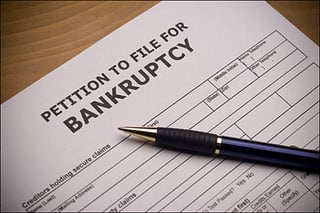 Most Americans are worried about money. In fact, for about a quarter of people dealing with debt issues, the stress is bad enough to create PTSD-like symptoms. Sometimes, a few hours of moonlighting per week and some financial sacrifices in other areas are sufficient to restore financial sanity. But in many other cases, that method will not work because there is simply too much debt. Making matters worse, moneylenders call and send letters almost daily, and each new communication is a little more threatening than the last one.
Most Americans are worried about money. In fact, for about a quarter of people dealing with debt issues, the stress is bad enough to create PTSD-like symptoms. Sometimes, a few hours of moonlighting per week and some financial sacrifices in other areas are sufficient to restore financial sanity. But in many other cases, that method will not work because there is simply too much debt. Making matters worse, moneylenders call and send letters almost daily, and each new communication is a little more threatening than the last one.
When money problems start to become overwhelming, contacting a Minneapolis Bankruptcy Attorney becomes a good option. A good Bankruptcy Attorney will discuss all your possible options with you. An even better one will help make life after bankruptcy better than it otherwise would be.
How a MinnEapolis Bankruptcy Attorney Provides Immediate Debt Relief
Whether you file Chapter 7 or Chapter 13, an automatic stay under Section 362 of the Bankruptcy Code takes effect immediately upon filing in most cases, and generally lasts as long as the bankruptcy case is pending. The stay offers immediate relief to distressed debtors. If these debtors successfully complete a Chapter 13 bankruptcy as outlined below, or even a Chapter 7 in many cases, they will essentially be debt-free after the automatic stay is lifted.
The Key Features of Chapter 7 Bankruptcy
Medical bills are one of the leading sources of financial stress. Even if the debtor has health insurance, copayments and unreimbursed expenses can be financially crippling. Chapter 7 eliminates most such unsecured debts, usually within about four months.
Chapter 7 is sometimes called “liquidation” bankruptcy, but that term is quite inaccurate. While it is true that the trustee (person who manages the bankruptcy for the judge) may seize and sell nonexempt assets, most assets in Minneapolis are exempt. The list includes:
- Home Equity: Minnesota has one of the largest homestead exemptions in the country. Debtors may exempt up to $390,000 for a primary residence; if the residence is used primarily for agriculture, the exemption skyrockets to $975,000.
- Vehicles: Each debtor may exempt up to $4,600 in vehicle equity. New cars usually have almost no equity and used cars usually have almost no monetary value, so Minnesota trustees almost never seize family cars.
- Retirement Accounts: The United States Supreme Court confirmed that 401ks, and most other retirement nest eggs are 100 percent exempt, no matter how much money they contain and IRAs are exempt up to more than $1.2 million.
- Personal Property: Under state law, debtors can exempt about $25,000 in furniture, tools of the trade, jewelry, personal injury settlements, and other personal property.
- Wages: Many states do not have a wage exemption, but Minnesotans can exempt up to 75 percent of their unpaid wages and 75% of any bank balance that can be attributed to wages deposited in a bank account within 20 days are also exempt.
Minnesota is one of 15 states in the country that allows debtors to elect either the state exemptions which are outlined above, or the federal exemptions set out in the Bankruptcy Code. In many ways, the two are basically the same; the main difference being the Minnesota exemption for homestead real estate is much more generous than the federal exemption, and the Bankrupt Code exemptions contain a “wild card” exemption – to cover otherwise non-exempt assets, while Minnesota law has no similar provision. Most debtors who elect to use Bankruptcy Code exemptions can use $13,100 to protect otherwise nonexempt property, such as cash in a savings account.
After a brief meeting in which the trustee essentially verifies the paperwork filed with the court, the bankruptcy judge signs a discharge order.
Once the bankruptcy is over, Kain & Scott offers free credit repair. The program has a number of features, including a dedicated credit repair specialist and exclusive referrals to lenders who work with people who have filed bankruptcy. In many cases, after a few years pass, many former Chapter 7 debtors do not even remember that they filed bankruptcy.
Breaking Down The Chapter 13 Bankruptcy
When the debtor files a Chapter 13 petition and schedules, the filing includes a proposed debt consolidation payment. The payment is based on the debtor’s family budget, and not on the amount the moneylenders demand. The protected repayment period lasts up to five years, during which time the automatic stay usually remains in effect. At the end of the repayment period, secured debts, such as home mortgage notes, are current, and any remaining unsecured debts are discharged.
It’s important to note that debtors may voluntarily convert from Chapter 13 to Chapter 7 at any time. Many people begin in Chapter 13, and if they cannot afford the monthly debt consolidation payment, they convert to Chapter 7, so they get their fresh starts even sooner.
Distressed debtors have a number of bankruptcy options. For a free consultation with an Minneapolis Bankruptcy Attorney contact Kain & Scott, P.A. We’ve helped Minnesotans get a handle on their debt since 1972.
Kain & Scott, P.A.100 South Fifth Street #1900
Minneapolis, MN 55402
(612) 843-0527
info@kainscott.com


